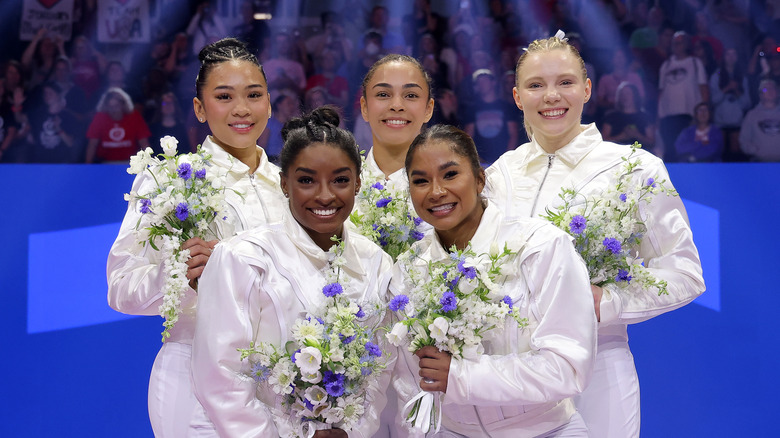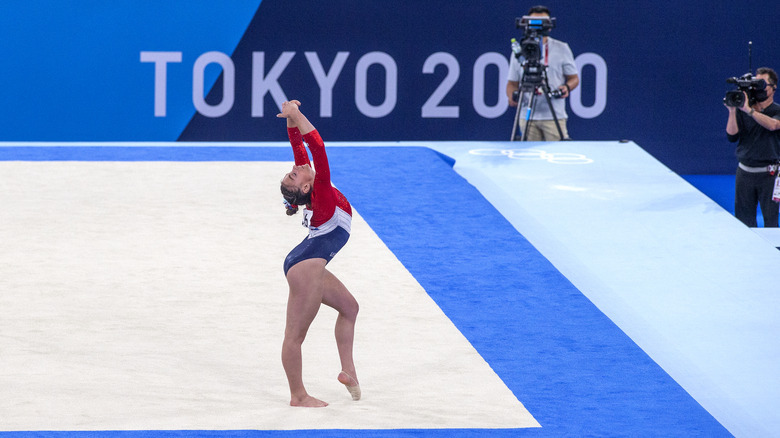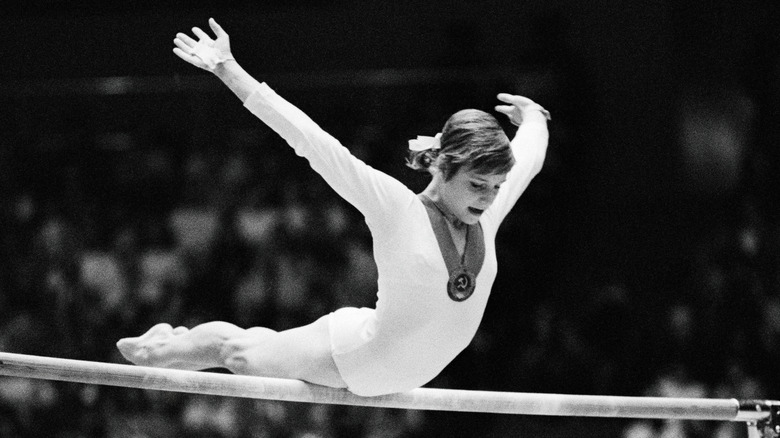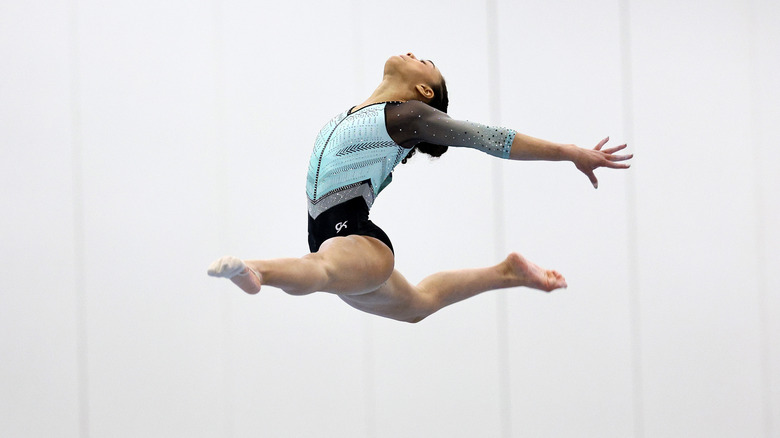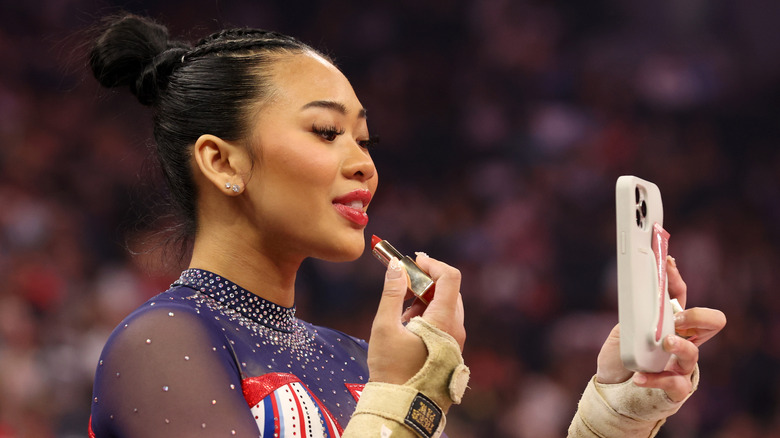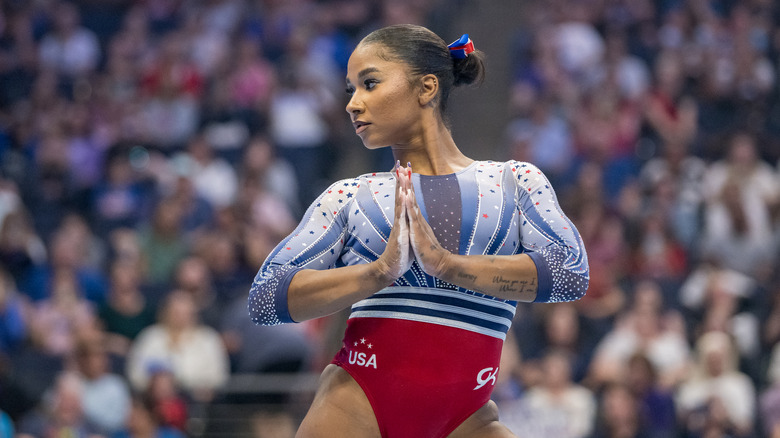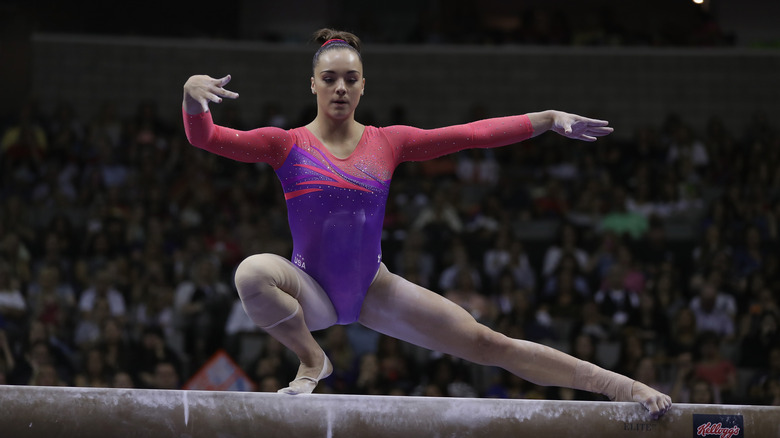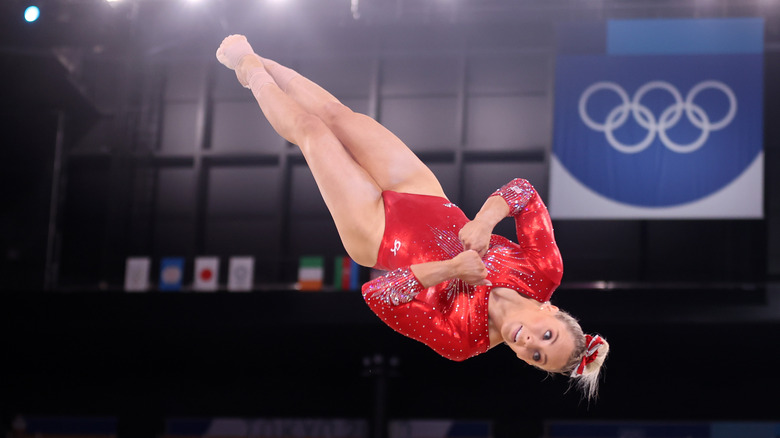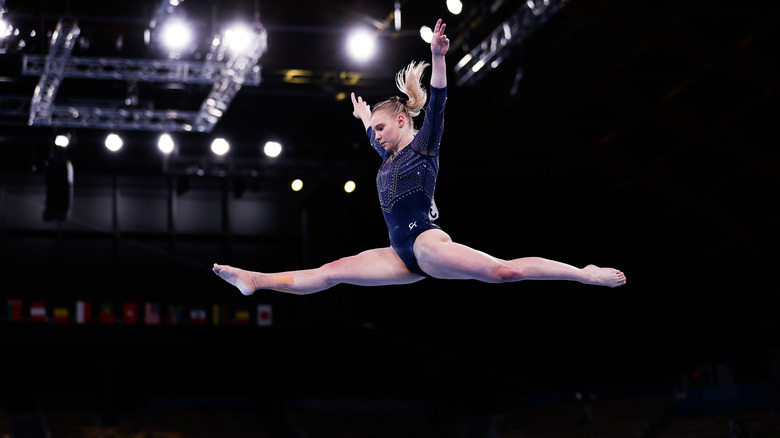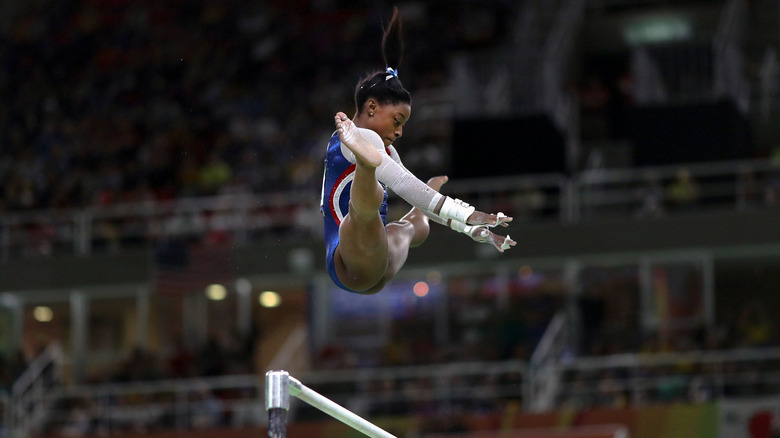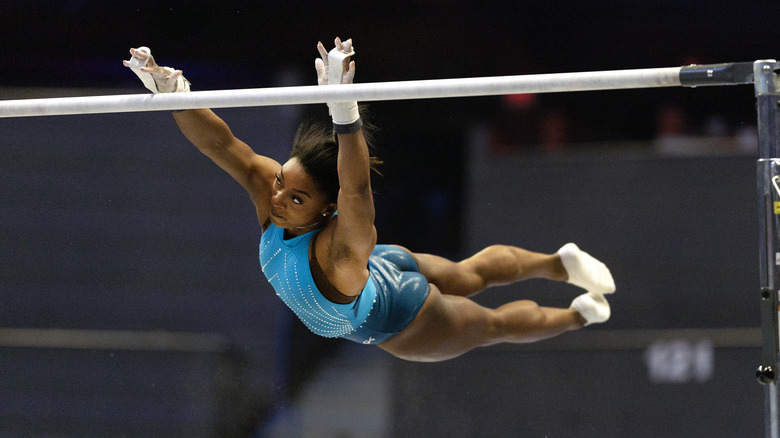Strict Rules Olympic Gymnasts Are Not Allowed To Break
Women's gymnastics is one of the most highly anticipated events of the Summer Olympics, and it's easy to see why. With veterans like Simone Biles and Team USA newbies like gymnast Hezly Rivera, the 2024 Women's Olympic team put on a stellar show.
Despite its glowing popularity, the sport of gymnastics has a sinister history. Numerous Olympic gymnasts have spoken out about the verbal abuse and body shaming they experienced at the hands of their coaches. One of those gymnasts was Dominique Moceanu, who competed in the 1996 Olympic Games. "The methods they used of threats and body shaming and humiliation as a tactic to motivate you to perform better, or calling you names of being fat or overweight were methods of physiological and emotional abuse," Moceanu told People in 2016. "That does not create success for athletes."
In recent years, the gymnastics community has taken extra steps to improve safety and transparency within the sport. Today, many gymnasts, including Simone Biles, are optimistic about the future. "Back in the day, everybody had a more slim body and was really flexible and skinny," Biles told Glamour in 2021, "but now you can be a little bit shorter and more powerful like me. So I definitely think it's evolved." And while things have certainly improved within the culture of gymnastics, Olympic gymnasts are still held to incredibly high standards. If competitors follow these strict guidelines, they're sure to shine like Olympic gold on competition day.
Olympic gymnasts are expected to embrace a nutrient-dense diet
For the vast majority of athletes, diet and performance go hand in hand — and Olympic gymnasts are no exception. While there aren't necessarily any hard-and-fast dietary rules for these athletes, they are expected to be in peak physical shape while competing. To that end, many gymnasts follow a tightly controlled diet featuring rich proteins and nutrient-dense foods. In 2014, former Olympian Alicia Sacramone dished to Fashionista about her dietary regimen, which involved abstaining from foods that slowed her down. "When I'm training really heavily and during competition season I try to shy away from dairy and gluten," she explained. "It just really makes a difference in how I train, how I recover and how I rest."
As for gold medalist Simone Biles, her diet is packed with lean meats, protein, and fiber-rich vegetables. Some of her go-to dishes include grilled chicken, fish, and protein shakes. "I do not track anything," the champion told Women's Health in 2020. "I eat what I feel good with and try not to overeat or stuff myself because I'm always at the gym." She added, "For gymnasts, in particular, [tracking] can lead to health problems and eating issues, so I just eat what I know I can and should." When she wants to indulge, Biles reaches for hearty treats like fettuccine alfredo and s'mores cookies.
They must avoid illegal moves
During the Olympic Games, gymnasts are sure to bust out their most elaborate and impressive moves — however, gymnasts aren't allowed to perform any skills that have been declared illegal by the Federation Internationale de Gymnastique (FIG). Usually, moves end up on the FIG's blacklist when they're considered too dangerous to perform. Such is the case for several gymnastics skills — including the Korbut flip, which was popularized by gymnast Olga Korbut at the 1972 Olympic Games. The stunt involves standing on the tallest uneven bar, launching into a backflip, and re-catching the bar. Korbut pulled the move off flawlessly in 1972, but the Korbut flip was later banned by the FIG.
For some competitors, the benefits of doing a perilous move are well worth the risk. That was the case for Indian gymnast Dipa Karmakar who performed an incredibly precarious vault move called the Produnova at the 2016 Olympics in Rio. To execute the risky stunt, a gymnast must fly into a front handspring and catapult themselves through the air in a double somersault. The move is not for the faint of heart; it's often referred to as the "vault of death" due to the high risk of injury to the spine. "To achieve something in life, you have to take risks," Karmakar explained to the BBC. "The Produnova is the most difficult vault in female gymnastics. Only five women in the world have ever landed it. And I am one of them."
While performing, Olympic gymnasts should deliver head-to-toe perfection
Olympic gymnastics scoring is based on two major factors: first is the difficulty score (or D score) which determines the difficulty level of the routine. Gymnasts also receive an execution score (or E score) to assess how well they perform each move. In order to win an Olympic medal, a gymnast must deliver the full package: a robust, high-level routine and a magnificent execution. Too many errors could ruin an athlete's shot at an Olympic medal — therefore, gymnasts need to deliver head-to-toe perfection. Even the slightest mistakes — such as flexed feet, bent knees, wobbling, or crossed legs — will result in a deduction of points. Not only will gymnasts be docked for these tiny errors, but they could also lead to some awkward Olympic gymnastics moments.
Still, when it comes to scoring, judges don't always make the right calls. During the U.S. Classics in 2021, Simone Biles made jaws drop when she landed a move called the Yurchenko. Though she was the first woman ever to complete the vault move, she received a lackluster difficulty score. The panel blamed their decision on the fact that the Yurchenko is an excessively dangerous skill. However, some critics — including Biles herself — felt as though the gymnast was being graded on a curve. "They're both too low and they even know it," Biles told The New York Times in 2021. "But they don't want the field to be too far apart."
Olympic gymnasts have to follow certain grooming regulations
Not only do Olympic gymnasts have to worry about seemingly innocuous things like toe points and bent knees, but they also have to take their physical appearance into consideration when competing. That's because USA Gymnastics has strict rules when it comes to overall presentation. According to the USA Women's Gymnastics Handbook, a gymnast must be "well groomed in her appearance." Competitors are also banned from wearing any jewelry except small stud earrings.
As far as grooming goes, the handbook states that hair should be pulled back off of the face. Gymnasts are allowed to wear nail polish, as gymnast Suni Lee demonstrated with her Olympics-inspired acrylics in 2021. However, manicures must be pre-approved by the athlete's coach. According to former Olympic gymnast Nastia Liukin, U.S. coaches typically prefer subtle colors. "For every country, it depends on what your head coach likes, and what they don't like," Luikin told People in 2016. She added, "I always had like a light, light, light pink on my toenails and then nothing really on my nails."
Despite the strict grooming policies, Olympic gymnasts don't have to submit to a boring beauty routine. There aren't any regulations when it comes to makeup, and many competitors take full advantage of the opportunity to serve up some Olympic glam. "You are allowed to have lipstick on," Liukin confirmed. "In the last two Olympics, they've really stepped it up. I've seen a red leotard with a bright red lip."
Olympic gymnasts should heed etiquette rules
In addition to looking and performing their best, Olympic gymnasts also need to be on their best behavior. As USA Gymnastics notes in their handbook, proper conduct and good sportsmanship are critical when competing — especially when you're representing your country in the international arena. That said, there are a few behaviors that gymnasts are strictly banned from partaking in. For example, no food or drinks are allowed in the competition area with the exception of bottled water. Additionally, gymnasts are forbidden from wearing in-ear headphones or talking on the phone while competing.
When you're participating in the Olympics, good sportsmanship is a must. Therefore, gymnasts aren't allowed to question or criticize their score. The handbook demands that athletes "be courteous, respectful, and polite to all meet officials, coaches, hostesses, competitors, and associated persons." If a gymnast falls or gets injured while competing, they're expected to maintain a calm and professional demeanor.
One of the more controversial rules imposed on gymnasts is Rule 50, which prohibits all Olympic athletes from engaging in any form of political protest during Olympic events. Numerous athletes and critics have slammed the International Olympic Committee (IOC) for this seemingly contradictory rule. In 2021, the advocacy group EU Athletes declared that the policy was "not only inconsistent with human rights, but also goes against the values that the IOC claims to support."
In some cases, Olympic gymnasts are pressured to maintain a certain weight
Like many competitive sports, gymnastics has a disturbing history of pushing athletes past the brink of physical and emotional wellness. In the last few decades, numerous gymnasts have come forward to speak about the abuse and exploitation they suffered during their careers. In 2021, former Olympic gymnast Dominique Dawes told The Washington Post, "Young gymnasts push through agony and sickness out of fear and compete in emotional and physical pain." Not only have gymnasts reported feeling pressured to train at the expense of their health, but some have also denounced the industry for catalyzing body image issues and eating disorders. Retired gymnast Maggie Nichols is one of several gymnasts who have spoken out about these issues.
In her memoir, "Unstoppable!" Nichols revealed that her coach ridiculed her for looking "puffy" and ordered her to shed pounds by running on a treadmill after her daily practices. "That's when things took a turn," the gymnast wrote. "Food became a struggle for me. Now my coach was weighing me instead of me just doing it privately at home." In light of the abuse of Nichols and numerous other gymnasts, some countries have adopted stricter policies regarding weigh-ins. For example, in 2023, Britain banned gymnastics coaches from weighing underaged gymnasts without consent from both the athlete and their parents.
Underwear must never be visible
When competition day rolls around, the last thing Olympic judges want to see is an underwear line or a rogue bra strap. As such, Olympic gymnasts should never leave their underwear visible. According to the USA Gymnastics rulebook, "No underwear (including sport bras) should be deliberately exposed." However, the handbook also notes that there is one exception to this rule: "a clear bra strap is acceptable." Fortunately, Olympians have the option to wear custom-made skivvies under their leotards; that way, they don't have to sacrifice comfort while performing. In addition to hiding their underwear, gymnasts must also avoid wearing backless leotards, spaghetti straps, and midriff-bearing attire. Athletes who break these sartorial guidelines can end up losing 0.20 points.
Over the years, some countries have amended their policies around undergarments. For example, in 2024, New Zealand announced that points would no longer be deducted from gymnasts due to visible underwear. The amendment only applies to competitions that take place in New Zealand — however, some athletes believe that the international gymnastics community should follow the country's lead. "Females in sport have always battled with societal norms every day," rhythmic gymnast Aimee Didierjean told Newsroom. "With shorts and leggings now able to be worn, or having your bra strap showing and not being deducted for it, it will help steer away from that toxic culture of body image and stereotypes."
Olympic gymnasts have to pick the right music for floor routines
It goes without saying that Olympic gymnasts put a lot on the line in the pursuit of a gold medal. Not only are they representing their country on the most elite international stage, but many gymnasts train their entire lives for a chance to stand on the Olympic podium. And with so much at stake, the last thing a gymnast would want to do is pick a floor exercise song that totally dashed those chances.
First things first, the music for the routine has to be instrumental. "Lyrics have never been allowed, which is why we don't see gymnasts dancing to popular songs very often," author and former gymnast Georgia Cervin explained to CNN. Now, that's not to say popular songs aren't allowed. If a gymnast is set on doing their floor exercise to a bop by their favorite Top 40 artist, an instrumental cover is totally fine — it just has to be 90 seconds long and fit the choreography.
What's more, a gymnast can lose points if they hit their final move before or after the song ends. This shouldn't come as a surprise, but when Simone Biles arrived at the 2024 Olympic Trials with an instrumental mashup featuring Taylor Swift and Beyoncé, she did not miss a beat. And no, she didn't miss the points, either.
Olympic gymnasts must never skip practice
coIt's no secret that Olympic gymnasts spend inordinate hours in the gym. After all, if you want to be able to flip and tumble with the best of them, then training is a must. In order to qualify for the Olympics, gymnasts need to master an array of high-level skills. And when it comes to their Olympic routines, each movement has to be perfectly executed. Every second in the gym counts.
So, just how many seconds in the gym are required of an Olympic gymnast? It varies from athlete to athlete, but the short answer is: a lot. In 2021, Simone Biles dished to Glamour that she spent between 32 and 34 hours a week in the gym. In early 2024, Suni Lee told Olympics.com that she'd devoted somewhere around 56 hours of her week to training. Hezly Rivera may be new to Team USA, but she's not new to putting in serious minutes at the gym: According to NBC 5 Dallas-Fort Worth, she balances six hours of training a day with her school schedule.
Training is not only vital for winning competitions — it's also essential for keeping gymnasts' bodies strong and healthy. Thus, Olympic gymnasts should never cut corners on their gym routine. What's more, making time to let the body and mind recover from the training is also crucial. That could mean anything from going in for a massage, dipping into an ice bath, or, as Jordan Chiles told Olympics.com, unwinding with a manicure.
Picking a wedgie could be costly
If you've ever seen a women's Olympic gymnastics competition, then you've probably noticed that things tend to get a bit cheeky in regards to their leotards. Due to the snug fit of Olympic uniforms, it's totally common for the fabric to ride up, leaving a gymnast with an uncomfortable wedgie. These fashion bloopers are par for the course when it comes to the sport, and gymnasts generally don't get too self-conscious about them (after all, their main objective is to score the coveted gold medal). Not only are wedgies a perfectly normal sight at Olympic gymnastics competitions, but they should also be left alone while the gymnast is performing. Yes, that means picking a wedgie is against the rules of Olympic gymnastics. According to former Olympian Nastia Liukin, gymnasts can actually get docked points if they're caught trying to pick a wedgie.
Adjusting a wedgie may be against the rules, but Olympic gymnasts have a few techniques for keeping their leotards from crawling into awkward places. "You're not allowed to [pick a wedgie] or else you get deducted," Liukin dished to People in 2016. "So a lot of people use like sticky spray [called TuffSkin] for your butt so your leotard doesn't move." She added, "But if you have a fall and your leotard goes up your butt, you don't want to fix it in the middle of your routine." Liukin explained that competitors should wait until they're on the sidelines before they deal with any wandering fabric.
